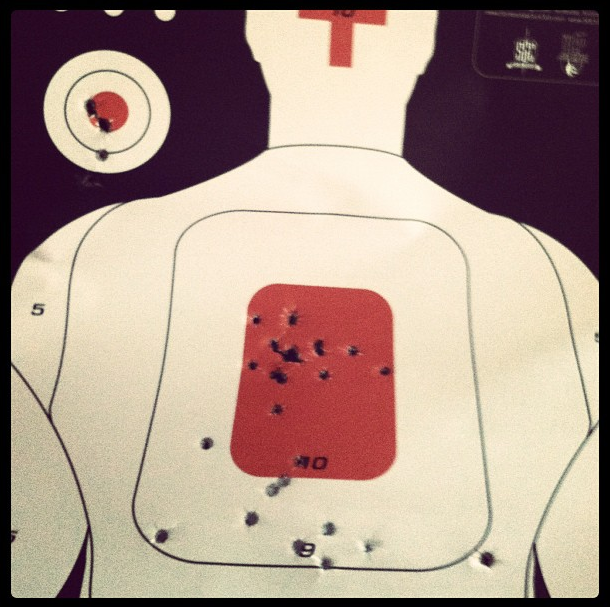Writing About Guns: 7 Screenplay Do's and Dont's
I'm an action/thriller writer with an emphasis on the spy and assassin subgenres, so most of my scripts have guns. Scratch that: ALL of my scripts have guns. That's why my research brought me to the largest indoor gun range in the country, where I got to learn all about firearms from one of the experts in the industry.
Here are some of the rules I learned when putting firearms in the hands of your characters:
DON'T confuse "magazine" and "clip." When loading a handgun, the section that holds the bullets is called a magazine because it encases all of the bullets so that you can only see the top one. 90% of the time you will use the term magazine. "Clip" only refers to the kind of ammunition holder that has exposed bullets, and clips are commonly used with rifles or guns from World War numero dos. So please, use the term "MAGAZINE" or else the gun-toting community will walk out on your movie and write you off as somebody who doesn't care enough about their script to do the research.
DO know what type of gun your characters would carry? Police units prefer Glocks not only because they're nearly indestructible and have a passive safety, but also because standardizing on firearms means that during intense or prolonged shootouts, they can easily trade *magazines* if one of the officers gets hit and is unable to use his gun. Glocks are also lighter and more practical, whereas something like the 1911 is more showy and has the greatest number of possible accessories and add-ons because its design hasn't changed in over one hundred years. Berettas, despite their mystique and position as the oldest firearm out there -- the Beretta has been around for the past five hundred years -- they aren't as reliable as Glocks when it comes to certain parts breaking or not working properly. The H-K (aka: the Jack Bauer gun) has a cult-like following and people who use H-K's often refuse to use anything else. It is more on the expensive side, but it's one of my favorites because the kickback isn't as intense as the Glock because the Glock is made out of plastic, and the HK I used is steel. (See photo below.)
Being a writer is a pretty cool gig!
DO know the standard technique for firing a gun: Is your character firing the gun sideways, holding it with one hand, and yelling "KILL SHOT!" as they run around, trying to hit a moving target? Their accuracy is going to be terrible. I don't care who they are: between the kickback of the gun and the near impossibility of lining up your sights without two hands steadying the weapon, there is no way they can hit their targets. Ideally, your character should be in an isosceles stance (feet shoulder length, sometimes the left a little out in front) leaning forwards with a straight spine and a slight bend at the elbows and knees. Don't squeeze the trigger, don't pull the trigger. PRESS the trigger. Try and isolate your index finger, and don't clench up your whole arm.
DON'T use laser sights unless it makes sense: Let's be honest with ourselves here. Laser sights just look cool, and the moment when a character sees a red dot on their shirt is a great way of making the imminent danger visual. However, lasers have to be adjusted for a certain range. If you set your laser for fifteen feet, you won't be able to shoot at anything with accuracy in the 20ft range. Snipers? Go ahead, use a laser. Wild pursuits? Forget about it. Lasers are meant as a deterrent and are more of a gimmick than an actual, useful tool.
I’m no James Bond, but I’m still a decent shot!
DO know what situations your characters will be in: So your character's car just nosedived into the nearby lake, and he needs to fire at bad guys underwater. He sure as hell better be carrying a Glock. What about firing more than six times without reloading? Better skip on that revolver. Go for a handgun with a double stack instead (AKA: nearly any handgun except for the 1911), because that holds fifteen rounds per magazine.
DO know the difference between calibers? The "big three" calibers (aka: size of the bullet) is as follows: 9mm, .40'', .45''. And yes, the first one is commonly expressed in the metric system. In inches it's more like .355, but nobody says that. The difference of the size of the bullet affects the velocity of the gun. Ideally, most characters would use 9mm, because in the gun world a 9mm is like a Corvette. Fast, light, and plenty powerful. A .40 is like a Chevy Silvarado, and a .45 is akin to a monster truck. The bigger the caliber, the bigger the hole. For screenplay purposes, stick with a 9mm.
DON'T stuff too much technical lingo into your script. As much as I'd love to show off in my script by devoting several scenes to my characters firing guns and chatting about the history behind the Glock, I won't. Use enough of your research to advance the script and reveal character. Story comes before everything else.
Use research to improve your credibility and add specific details where they're needed!
What to Read Next
Are you pursuing a creative career and need money and flexibility? Check out how to do it with my book Six-Figure Freelance Writer: A Holistic Guide on Finding Freedom in Freelancing.


